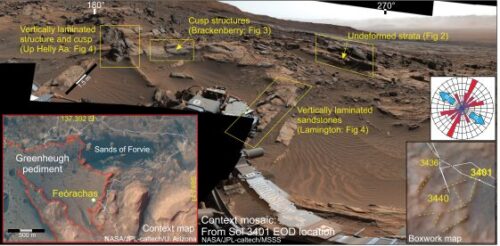2024-03-22 インペリアル・カレッジ・ロンドン(ICL)
<関連情報>
- https://www.imperial.ac.uk/news/252234/water-persisted-mars-gale-crater-longer/
- https://pubs.geoscienceworld.org/gsa/geology/article/doi/10.1130/G51849.1/636785/Ice-Salt-Pressure-Sediment-deformation-structures
氷?塩?圧力?火星ゲールクレーターにおける後期浅層地下水の証拠としての堆積物の変形構造 Ice? Salt? Pressure? Sediment deformation structures as evidence of late-stage shallow groundwater in Gale crater, Mars
Steven G. Banham;Amelie L. Roberts;Sanjeev Gupta;Joel M. Davis;Lucy M. Thompson;David M. Rubin;Gerhard Paar;Kirsten L. Siebach;William E. Dietrich;Abigail A. Fraeman;Ashwin R. Vasavada
Geology Published:March 22, 2024
DOI:https://doi.org/10.1130/G51849.1

ABSTRACT
Persistence of near-surface water during the late evolution of Gale crater, Mars, would have been fundamental for maintaining a habitable environment. Sedimentation in aqueous conditions is evident during the early stages of crater infilling, where accumulation of lower Mount Sharp group strata is characterized by fluviolacustrine sedimentary rocks. The basal unit of the Siccar Point group—the Stimson formation—which unconformably overlies the Mount Sharp group and represents conditions postdating the exhumation of Aeolis Mons, is characterized by accumulation of aeolian strata under arid conditions. Water was largely absent near the surface during its deposition. At the Feòrachas outcrop, discovery of soft sediment deformation structures in aeolian Stimson strata challenges the notion that Gale crater was devoid of water during its later depositional phase. We identified deformed wind-rippled and vertically laminated sandstones, hosted within erosion-resistant ridges forming boxwork patterns. Broadly, these structures are diagnostic of water (as liquid or as ice) in the shallow subsurface. Comparison with Earth analogues suggests formation by subsurface fluid escape, freeze-thaw processes, or evaporite deformation. Regardless of the mechanism, these structures signify the presence of water at or near the surface much later than previously documented and may extend the habitability window in Gale crater.



